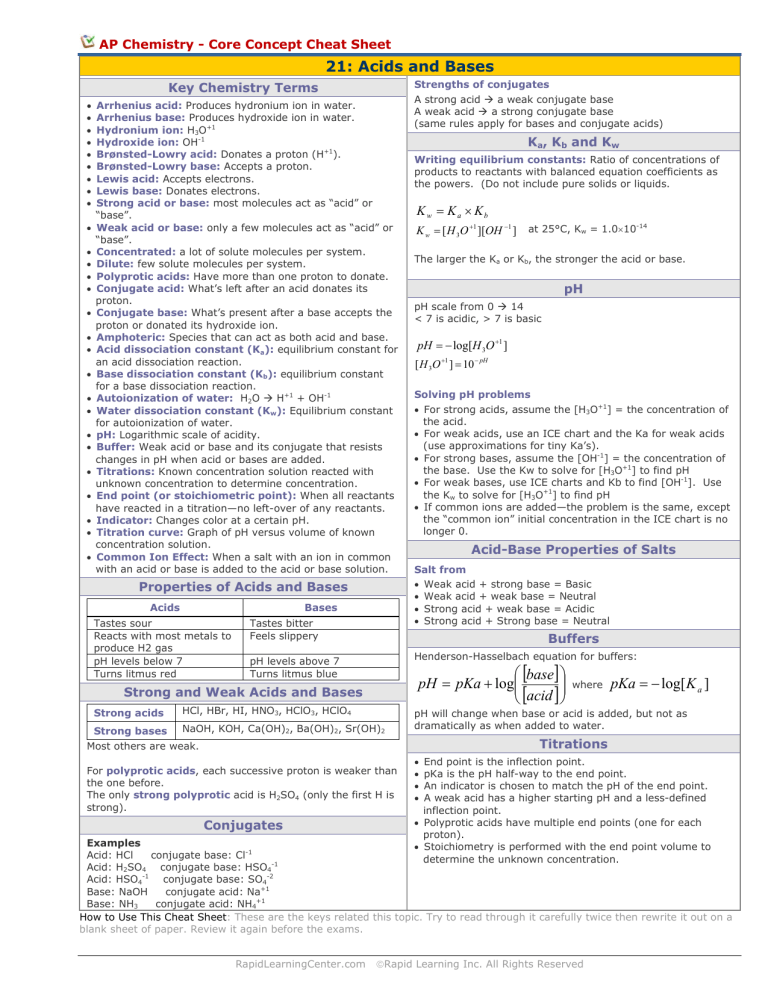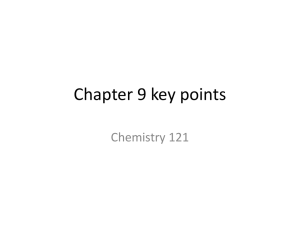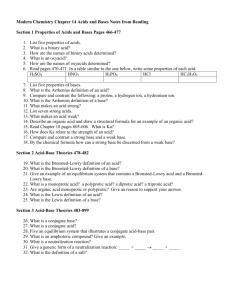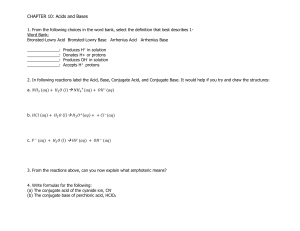
AP Chemistry - Core Concept Cheat Sheet 21: Acids and Bases Key Chemistry Terms • • • • • • • • • • • • • • • • • • • • • • • • • • • Arrhenius acid: Produces hydronium ion in water. Arrhenius base: Produces hydroxide ion in water. Hydronium ion: H3O+1 Hydroxide ion: OH-1 Brønsted-Lowry acid: Donates a proton (H+1). Brønsted-Lowry base: Accepts a proton. Lewis acid: Accepts electrons. Lewis base: Donates electrons. Strong acid or base: most molecules act as “acid” or “base”. Weak acid or base: only a few molecules act as “acid” or “base”. Concentrated: a lot of solute molecules per system. Dilute: few solute molecules per system. Polyprotic acids: Have more than one proton to donate. Conjugate acid: What’s left after an acid donates its proton. Conjugate base: What’s present after a base accepts the proton or donated its hydroxide ion. Amphoteric: Species that can act as both acid and base. Acid dissociation constant (Ka): equilibrium constant for an acid dissociation reaction. Base dissociation constant (Kb): equilibrium constant for a base dissociation reaction. Autoionization of water: H2O Æ H+1 + OH-1 Water dissociation constant (Kw): Equilibrium constant for autoionization of water. pH: Logarithmic scale of acidity. Buffer: Weak acid or base and its conjugate that resists changes in pH when acid or bases are added. Titrations: Known concentration solution reacted with unknown concentration to determine concentration. End point (or stoichiometric point): When all reactants have reacted in a titration—no left-over of any reactants. Indicator: Changes color at a certain pH. Titration curve: Graph of pH versus volume of known concentration solution. Common Ion Effect: When a salt with an ion in common with an acid or base is added to the acid or base solution. Properties of Acids and Bases Acids Bases Tastes sour Reacts with most metals to produce H2 gas pH levels below 7 Turns litmus red Tastes bitter Feels slippery Strengths of conjugates A strong acid Æ a weak conjugate base A weak acid Æ a strong conjugate base (same rules apply for bases and conjugate acids) Ka, Kb and Kw Writing equilibrium constants: Ratio of concentrations of products to reactants with balanced equation coefficients as the powers. (Do not include pure solids or liquids. K w = K a × Kb K w = [ H 3O +1 ][OH −1 ] at 25°C, Kw = 1.0×10-14 The larger the Ka or Kb, the stronger the acid or base. pH pH scale from 0 Æ 14 < 7 is acidic, > 7 is basic pH = − log[H 3O +1 ] [ H 3O +1 ] = 10 − pH Solving pH problems • For strong acids, assume the [H3O+1] = the concentration of the acid. • For weak acids, use an ICE chart and the Ka for weak acids (use approximations for tiny Ka’s). • For strong bases, assume the [OH-1] = the concentration of the base. Use the Kw to solve for [H3O+1] to find pH • For weak bases, use ICE charts and Kb to find [OH-1]. Use the Kw to solve for [H3O+1] to find pH • If common ions are added—the problem is the same, except the “common ion” initial concentration in the ICE chart is no longer 0. Acid-Base Properties of Salts Salt from • Weak acid + strong base = Basic • Weak acid + weak base = Neutral • Strong acid + weak base = Acidic • Strong acid + Strong base = Neutral Buffers Henderson-Hasselbach equation for buffers: pH levels above 7 Turns litmus blue ⎛ [base] ⎞ pH = pKa + log⎜⎜ ⎟⎟ ⎝ [acid ] ⎠ Strong and Weak Acids and Bases Strong acids HCl, HBr, HI, HNO3, HClO3, HClO4 Strong bases NaOH, KOH, Ca(OH)2, Ba(OH)2, Sr(OH)2 where pKa = − log[ K a ] pH will change when base or acid is added, but not as dramatically as when added to water. Titrations Most others are weak. For polyprotic acids, each successive proton is weaker than the one before. The only strong polyprotic acid is H2SO4 (only the first H is strong). Conjugates • • • • End point is the inflection point. pKa is the pH half-way to the end point. An indicator is chosen to match the pH of the end point. A weak acid has a higher starting pH and a less-defined inflection point. • Polyprotic acids have multiple end points (one for each proton). • Stoichiometry is performed with the end point volume to determine the unknown concentration. Examples Acid: HCl conjugate base: Cl-1 Acid: H2SO4 conjugate base: HSO4-1 Acid: HSO4-1 conjugate base: SO4-2 Base: NaOH conjugate acid: Na+1 Base: NH3 conjugate acid: NH4+1 How to Use This Cheat Sheet: These are the keys related this topic. Try to read through it carefully twice then rewrite it out on a blank sheet of paper. Review it again before the exams. RapidLearningCenter.com ©Rapid Learning Inc. All Rights Reserved






